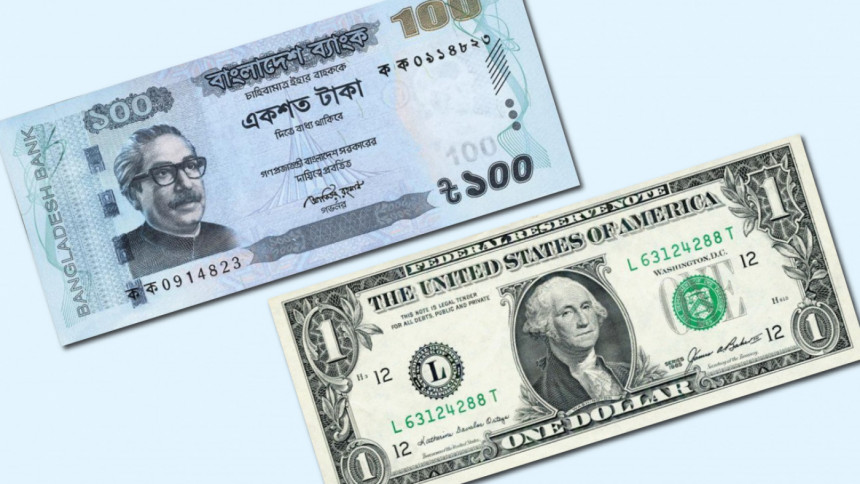Taka sees steepest fall in 16 years

The local currency saw a big dip in its value over the last two days after Bangladesh Bank floated exchange rates of the taka against the US dollar on June 2.
The taka fell by Tk 2.05 to Tk 91.95 per dollar, reflecting the shortage of the greenback in the country's foreign exchange market.
According to BB data, the local currency depreciated by Tk 1.60 against the dollar on Sunday, the biggest fall in a day since 2006. It again lost value by another Tk 0.45 yesterday, the 10th depreciation this year.
The central bank yesterday injected $130 million into the market to help banks settle their import bills. But the supply could hardly ease the dollar crunch.
The BB has so far injected $6.33 billion into market this fiscal year.
Experts say the central bank should immediately withdraw the interest rate cap on lending as it would help slow down the pace of depreciation of the taka against the dollar.
The BB imposed an interest rate cap of 9 percent on lending in April 2020. All banks have been following the ceiling to disburse loans since then.
Ahsan H Mansur, executive director of the Policy Research Institute of Bangladesh, said the decision to float the exchange rates was a good move, but it's not enough to restore stability in the foreign exchange market.
If the interest rate cap is withdrawn, interest rate on all loans will increase to some extent, and this will eventually make the taka dearer, he said.
The interest rate on post-import financing, which now stands at 9 percent, will increase substantially, meaning traders will feel discouraged to import goods, said Ahsan, also a former official of the International Monetary Fund.
The local currency is likely to see a big depreciation if the interest rate cap is not lifted, he said.
Withdrawal of the cap will give the taka a respite from the ongoing pressure, Ahsan noted.
Monzur Hossain, research director of Bangladesh Institute of Development Studies, also made similar observations.
He said depreciation of the local currency might have an adverse impact on inflation as it would push up import costs.
If the interest rate cap is withdrawn, the credit flow will decrease and money circulation will ebb away due to higher costs of credits, Monzur observed.
Inflation shot up to 6.29 percent in April -- the highest in 18 months -- amid persistent high prices of food and non-food items, shows data of Bangladesh Bureau of Statistics.
LOCAL MARKET SCENARIO
The Daily Star yesterday talked to officials of seven banks to know about the supply and demand of the greenback in the local market.
They said banks are still reluctant to sell dollars through the interbank platform as the majority of them are still facing a shortage of the greenback.
Yesterday, the banks officially set the selling rate of bills for collection, the rate at which lenders sell greenback to importers, between Tk 92 and 92.50 per dollar.
But many of them sold greenback to importers for as much as Tk 95.50 per dollar, ignoring their official rates. Such a violation is punishable, according to the BB rules.
Md Abdus Salam Azad, managing director of Janata Bank, said his bank offered importers Tk 92 per dollar yesterday.
"Now, we are running low on dollars to settle import bills … No private bank has agreed to sell greenback to us through the interbank platform.
"Moreover, I have been informed that some banks are selling greenback to importers for Tk 94-95 per dollar," he said.
Emranul Huq, managing director of Dhaka Bank, said it will take two to three months to bring back stability to the forex market.
GENESIS OF THE CRISIS
The country's import payments have shot up since the end of last year because of the rise in prices of commodities in the global market.
The pent-up demand after the height of the Covid pandemic initially played a pivotal role in pushing up commodity prices. The pandemic disrupted the global supply chain, deepening the crisis.
The latest Russia-Ukraine war worsened the situation further.
Against the backdrop, import payments of the country escalated in recent months, creating an immense pressure on the taka against the dollar.
Between July and April this fiscal year, imports went up by 41 percent to $68.66 billion, while exports grew 35 percent to $41.10 billion. This resulted in a record trade deficit -- the gap between exports and imports -- of $27.56 billion, up 53 percent year-on-year.
Moreover, remittance inflow fell 15.95 percent year-on-year to $19.19 billion in the first 11 months of this fiscal year.
All these led to the decline in the foreign exchange reserves to $42.11 billion on June 1 against $46.15 billion on December 31 last year.


 For all latest news, follow The Daily Star's Google News channel.
For all latest news, follow The Daily Star's Google News channel. 



Comments